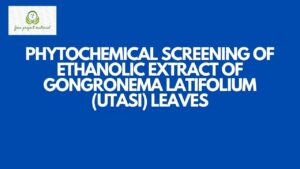ABSTRACT
This study was aimed at determining the phytochemical composition of Talinum triangulare. The sample was analyzed using standard analytical methods. The result of the study revealed the presence of alkaloids in high amount; tannins, flavonoids, and phenol in moderate amounts; saponins and cyanogenic glycosides in trace amounts while terpenoids were absent. This suggests that the plant can be a good source of various phytochemicals for medicinal purposes.
TABLE OF CONTENTS
Title Page – – – – – – – – – i
Certification – – – – – – – – – ii
Dedication – – – – – – — – – iii
Acknowledgement – – – – – – – – iv
Abstract – – – – – – – – – v
Table of Contents – – – – – – – – vi
CHAPTER ONE: INTRODUCTION
1.1 Background of the Study – – – – – – 1
1.2 Aim and Objectives of the Study – – – – 3
1.2.1 Aim – – – – – – – – – 3
1.2.2 The Objectives of this Study – – – – – 3
1.3 Scope and Limitation of the Study – – – – 4
CHAPTER TWO: LITERATURE REVIEW
2.1 Scientific Classification and Description
of Talinum traingulare – – – – — – 5
2.2 Chemical Composition of Talinum triangulare – – 7
2.3 Nutritional Benefit of the Plant – – – – – 8
2.4 Health/Medicinal Importance of Talinum triangulare – 9
2.5 Pharmacological Importance of Plant Phytochemicals – 11
2.5.1 Phenolic Acid – – – – – – – 11
2 .5.2 Flavonoids – – – – – – – – 12
2.5.3 Tannins – – – – – – – – 13
2.5.4 Alkaloids – – – – – – – – 14
2.5.5 Terpenes – – – – – – – – 15
2.5.6 Saponins – – – – – – – – 16
CHAPTER THREE: MATERIALS AND METHOD
3.1 Materials – – – – – – – – 18
3.2 Methods – – – – – – – – 18
3.2.1 Sample Collection and Preparation – – – – 18
3.2.2 Phytochemical Screening – – – – – – 19
CHAPTER FOUR: RESULTS AND DISCUSSION
4.1 Results – – – – – – – – 22
4.2 Discussion – – – – – – – – 23
CHAPTER FIVE: CONCLUSION AND RECOMMENDATION
5.1 Conclusion – – – – – – – – 26
5.2 Recommendation – – – – – – – 26
REFERENCES
CHAPTER ONE: INTRODUCTION
1.1 Background of the study
Talinum triangulare (Jacq) Wild commonly called waterleaf is a vegetable and belongs to the family Portulacaceae. It is an erect succulent herb which can be found as a natural weed and sometimes cultivated as a short-lived perennial herb. The mature plant measures between 30 cm and 60 cm in height. Vegetables are plants eaten as supporting food or main dishes and may be aromatic, bitter or tasteless (Nya and Eka, 2015).
The plant is found in West Africa, West Indies, South America and in warmer parts of the world. In Nigeria, its wide acceptance across various ethnic groups has earned it several local names such as “mgbolodi” (Igbo), “mmon-mmong ikong” (Efik/Ibibio) and as “Efo Gbure” (Yoruba) among others. The plant is cultivated during rainy season usually in a variety of habitats including road sides, open fields and abandoned agricultural lands (Edet and Sunday, 2007).
Vegetables vary considerably in their nutrient composition. Their carbohydrate content is low when compared with the starchy foods which form the bulk of the food eaten by man. They contain vitamins, essential amino acids, minerals and antioxidants (Fasuyi, 2006). Vegetables are the cheapest and most available sources of proteins, vitamins, minerals and essential amino acids. Some of the important vegetables grown in Nigeria include Amaranthus cruentus L., Telfaria occidentalis Hook. F., Gongronema latifolium Benth, Celosia argentea L., Vernonia amygdalina Del., and Talinum triangulare (Jacq) Wild.
Nutritionally, both the leaves and tender stems of T. triangulare are consumed as part of dietary supplement in starchy foods, sauces, condiments, spices and flavourings in human diet. They are also used as supplementary feeds to livestock such as rabbits, poultry, swine and cattle. The nutrient contents of the leaves of T. triangulare as reported by Mensah et al (2008) include carbohydrate, protein, ash, lipids, amino acids, moisture, crude fiber, ascorbic acid, pectin, potassium, calcium, magnesium, iron, sodium, beta-carotene and vitamins. Mensah et al. (2008) showed that the leaves or roots of T. triangulare are either employed singly or in combination with other medicinal herbs as diuretics in gastrointestinal disorders. The leaves are also used in the treatment of ailments such as oedema, dropsy, swellings and scabies. The use of the roots in preparing rat poison has been reported by Aiyeloja and Bello (2005).
Following the nutritional and medicinal importance of this plant, there is the need to evaluate the phytoconstituents of T. triangulare. This paper therefore examines the phytochemical properties of the leaves of T. triangulare.
1.2 Aim and Objectives of the Study
1.2.1 Aim
The aim of this study is to carry out the phytochemical screening of Talinum trangulare.
1.2.2 Objectives of the Study
(i) To identify the phytochemicals present in Talinum triangulare leaves.
(ii) To compare the result of the study with previous studies
(iii) To make useful recommendation based on the results of the study.
1.3 Scope and Limitation of the Study
This study focuses on the phytochemical screening of Talinum triangulare leaves. This is due to time and financial constraints.



